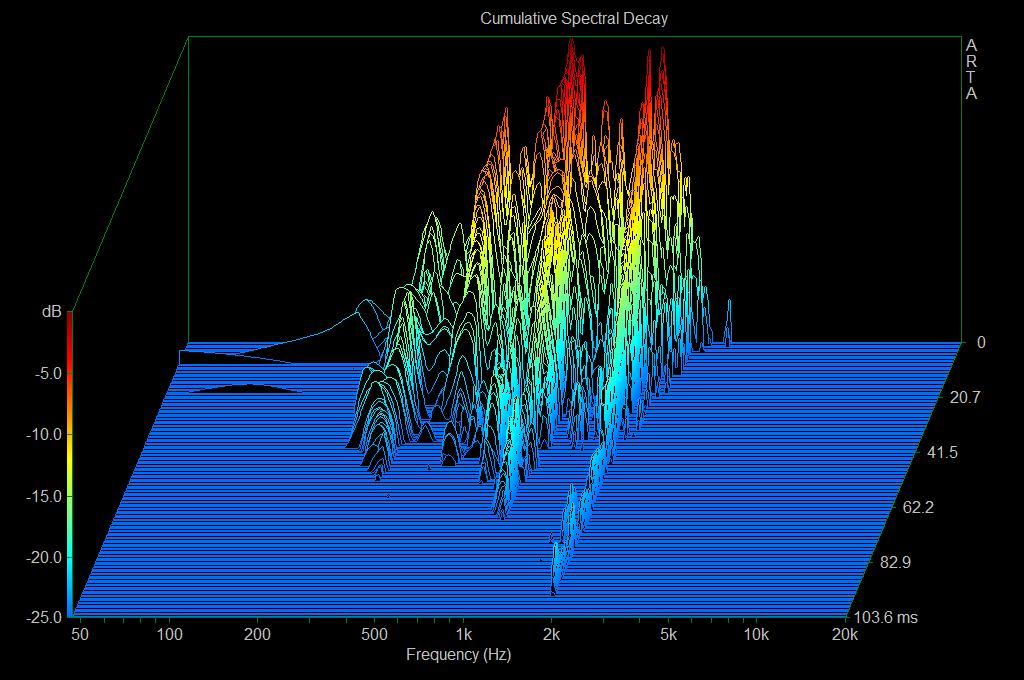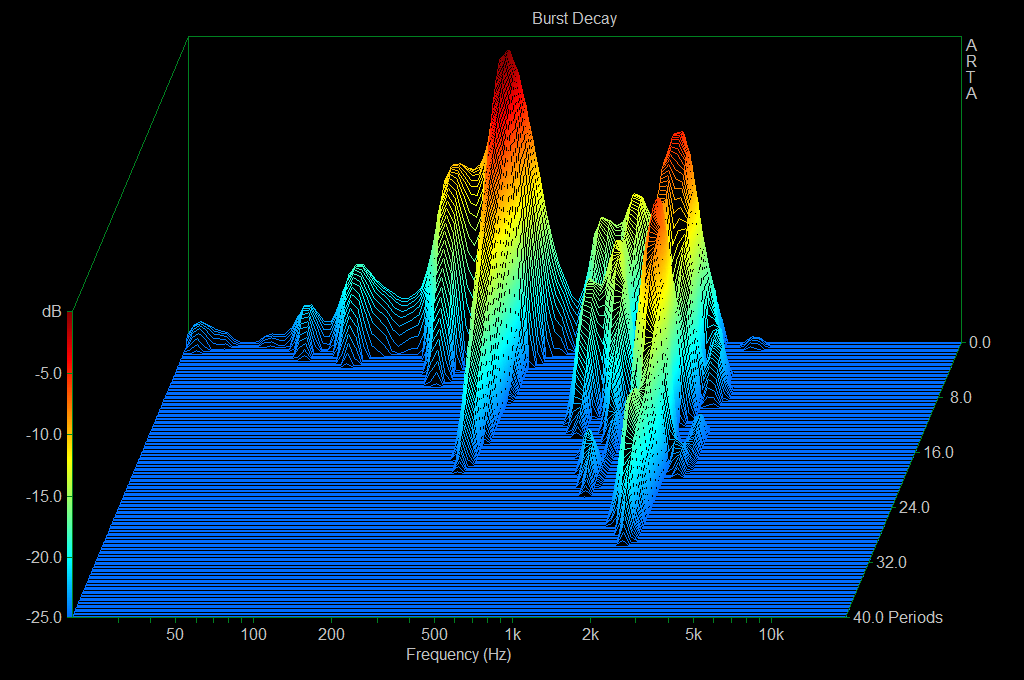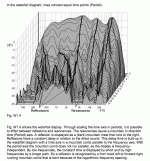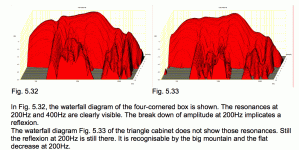Doug, read post 228 and 229. Answers all your questions. You won't find it in any links I'm aware of, but there really aren't any links on designing a CD loudspeaker. Most audio geeks just don't realize how necessary CD is as they have never heard it. Maybe Pi Loudspeakers might have something, but after read 228 and 229 it will be obvious. There is no book telling you what is in my opinion the most important stuff. Loudspeakers have been holding back listening for too many years.😉
Dan
I was reading them, first great work but all that talk is about 45 degree issues and not the 90degree. 90degree response drops off so fast that its just not audible and not worth worrying about because the issues will show at 45 degrees first.
Your notch filter had nothing to do with 90degree issue correct?
I think if you are concerned about 90deg then you might as well go all the way to 180deg because both to me are not as remotely important as even dealing with 45 deg. I would also cross that woofer you showed much lower then 1KHz so I wouldnt need a notch filter. The measurements show it has issues near 2KHz so we should be atleast one octave lower in the XO, no??
Im not the expert, Im learning as much as you are but one thing I have learned with building XOs (Active or simmed) is that you will always get down to a compromise somewhere....there is no such thing as perfection, there is a trade off always somewhere 😉 You will go bald and blind trying to worry about the more obscure issues and ignore the glaring ones.
Last edited:
This was a small demo of how tweaking the same driver can change the CSD. But also notice reflections along the cone and how they change depending on how it is tweaked. These are not the optimum, but shows how CSD can be useful. It's also possible to look at the impulse, but it's best to look at both. The impulse tells the location somthing is happening, but it's more difficult to look at the energy variation over time and how it shifts.
Last edited:
Thanks, I think CSDs are a useful tool when comparing drivers.
Take the D220ti vs BMS4540nd
Bad:

Better than average:

Take the D220ti vs BMS4540nd
Bad:

Better than average:

I still wonder if that 'tail' effects of the impulse are also in the CSD.
Yes, they would be - I've considered this in some detail - but I am not sure that it is obvious what they would look like - what would we look for? What is so obvious from CSD are the resonances ringing out, but these are just as obvious in the normal spectrum. The only thing that I have ever seen in a CSD that is not apparent in the FR is where two resonances that have a time delay between them create a null (hole) and this is seen as a decay of two peaks. That is hard to detect in the normal FR - its obvious in the impulse response however. But this is a relatively uncommon effect.
Thanks, I think CSDs are a useful tool when comparing drivers.
Take the D220ti vs BMS4540nd
Bad:

Better than average:

They would be a lot more useful (easier to interpret & compare) if:
1/ the time axis is in periods
2/ they are rotatable. Turns out that looking into the time-axis (ie a 2-D chart) is easiest to read... a good driver will have fairly flat, equally spaced curves
3/ they really need to reach down to -40dB or more (yours are at least meeting those requirements).
Is there a switch that lets you display time in periods?
dave
They would be a lot more useful (easier to interpret & compare) if:
1/ the time axis is in periods
2/ they are rotatable. Turns out that looking into the time-axis (ie a 2-D chart) is easiest to read... a good driver will have fairly flat, equally spaced curves
3/ they really need to reach down to -40dB or more (yours are at least meeting those requirements).
Is there a switch that lets you display time in periods?
dave
They are not mine, I do not have SoundEasy (I believe that is what generated them). I do think they give very easy comparisons and its easy to spot the better CD. Everyone that has used them has found them just fine so it depends on the person I guess.
1. What do you mean by periods. What is wrong with ms?
2. I like looking at 3D and not 2D (2D is boring). I like the new wavelets offered by some members of DIYaudio.com....These are typical compression drivers....none of them are flat when measured on a waveguide. Isnt the idea behind CSDs or wavelets is to see what driver has sound that "lingers"? I do not see how a 2D model can show that is a easy way.
3. It starts are 40dB and goes up to 100dB, that is a 50dB spread....any other difference is inaudible anyways.
Everyone has their particular needs in what they want. The only point I had in showing those was to prove that CSDs do have value .
Everyone has their particular needs in what they want. The only point I had in showing those was to prove that CSDs do have value .
I don't thinnk that you showed that. You showed two sets of data and said you liked one better. How does that "prove" that they have any value? The only "proof" of "value" that I have ever seen as regards measurements and perception is what Floyd Toole has done - frequency response at numerous angles matters. That was "evidence" even if it was not proof. I have never seen any "evidence" that CSD means anything other than a colorful show of data AND what people assume it all means. Audiophiles throw the word "proof" arround rather casually (I believe therefor it is) - it takes a lot to really "prove" something.
I don't thinnk that you showed that. .
You can not see the "stored energy" issue in the D220 meaurement?
The difference is night and day in those two CDs. The BMS is a far superior CD.
its not my opinion on what I like. Its the fact that the ripplies in the CSD are not a good thing in terms of SQ.
Maybe you do not look at CSDs that way but I choose my tweeter based on the better CSDs. No ripples, less ringing issues.
Last edited:
1. What do you mean by periods. What is wrong with ms?
It is hard to imterpret. What you want to look at is the ring-down of the device. Periods makes the portrayal of time axis equivalent across the bandwidth.
Photostory speaker acoustics audio measurement development OK² Nugget Dipol-Cardioid Kardioid free
A couple example from one of the papers attached below.
Given the discussion context, not the best example (wall panels -- and different measures)


2. I like looking at 3D and not 2D (2D is boring). I like the new wavelets offered by some members of DIYaudio.com....These are typical compression drivers....none of them are flat when measured on a waveguide. Isnt the idea behind CSDs or wavelets is to see what driver has sound that "lingers"? I do not see how a 2D model can show that is a easy way.
3D is needed if you have ms as time. Once you factor out that confounding information by switching to periods the 2D view gives curves you can analytically measure and removes the need for mental gymnastics.
They may not be as pretty as 3d graphs but are a whole lot more useful.
3. It starts are 40dB and goes up to 100dB, that is a 50dB spread....any other difference is inaudible anyways.
the spread from signal to floor (85 dB to 45 dB) is 40 dB. Don't count on the stuff that low down being inaudible. The difference between a good system and a REALLY good system is all down there.
dave
Attachments
Maybe you do not look at CSDs that way but I choose my tweeter based on the better CSDs. No ripples, less ringing issues.
See. Interpretation.
With a 2D periods based CSD, it becomes MUCH clear. Evenly spaced curves mean a consistant ring down thruout the units bandwidth (more important than less at some point but more elsewhere)
dave
See. Interpretation.
If someone can not spot that difference in the example then they have not look at CSDs long enough. There isn't much to do with interpretation, its all has to do with knowing what they look like.
Im not arguing what could be better. Im just saying for me CSDs show many things and are valuable. Someone like Geddes may not care much about CSDs because I doubt he is even doing driver comparisons.
Thanks for the explanation of Periods. I will have to check how Arta does this.
If someone can not spot that difference in the example then they have not look at CSDs long enough.
Spotting the visible differences is easy! Its prescribing some meaning to these differences that has been quantified by some valid tests. Thats whats missing. Its like THD - seeing the differences is easy, its the fact that these differences don't mean anything that is the concern.
Someone like Geddes may not care much about CSDs because I doubt he is even doing driver comparisons.
Thats not true at all. While I'm fixed on driver selection at the moment I have done dozens and dozens of different drivers in the past - maybe even hundreds (and that does not include the thousands of drivers for automotive).
Thats not true at all. While I'm fixed on driver selection at the moment I have done dozens and dozens of different drivers in the past - maybe even hundreds (and that does not include the thousands of drivers for automotive).
Sure but I would bet your budget allowed for in house testing. Im just thinking your position on this topic is a little different then a DIYer that has only so many options. All I know is that Zaph's CSDs have helped me select better drivers.
Im just thinking your position on this topic is a little different then a DIYer that has only so many options.
I don't see it as any different at all. We are both looking for the same things. I don't see anything in CSD that I can't see in a FR plot - you like them, OK. But I think that you are putting a lot of validity in something which has never been shown to have any - or at least no more than any other way of looking at the same data. It's not that CSD is useless, and I've never said that, it's simply no different. My point is that you need more data, ala polar response, not a different way of looking at the same data.
From earlier post by gedlee stating "there is only one right answer" therefore any answer which is not a member of the set which is the right answer the answer must be the wrong answer. Waterfall graphs are not in "the right answer" set and therefore are useless. I believe gedlee has outlined what is important to him and why. How about now on to what is important to others rather than this ongoing lobby for the gedlee answer only? Personally, I am very interested in what others have found important and really would like to learn more about that without the constant backtracking to the gedlee answer set only. I see no purpose in this backtracking. We know what gedlee believes. Let others show us theirs also please.
I generally agree with Earl. CSDs are just another way of looking at the frequency response. They are both mathematical manipulations of the same impulse response. Smooth frequency response (after all the EQ in the crossover) gives a smooth CSD. I know the other threads are trying to make a big deal of them but I remain skeptical. How they look depends entirely too much on the settings you choose when you do the CSD and how that particular software does the math.
- Status
- Not open for further replies.
- Home
- Loudspeakers
- Multi-Way
- Measurements: When, What, How, Why

